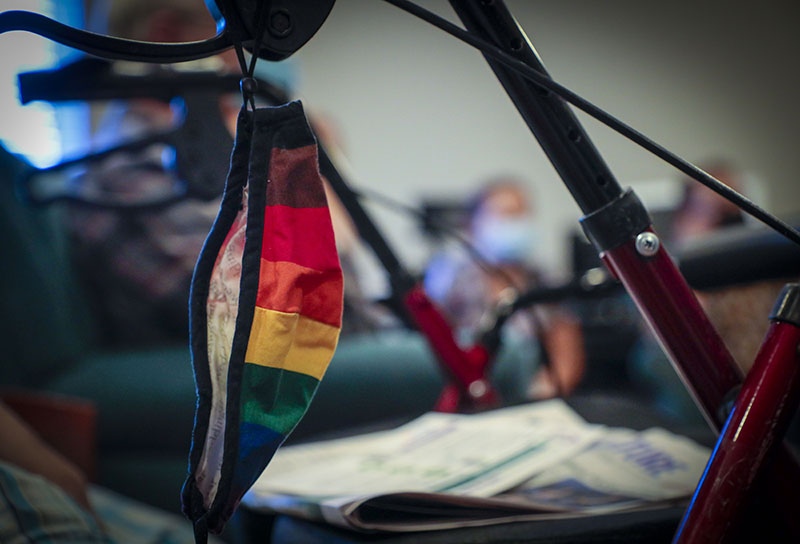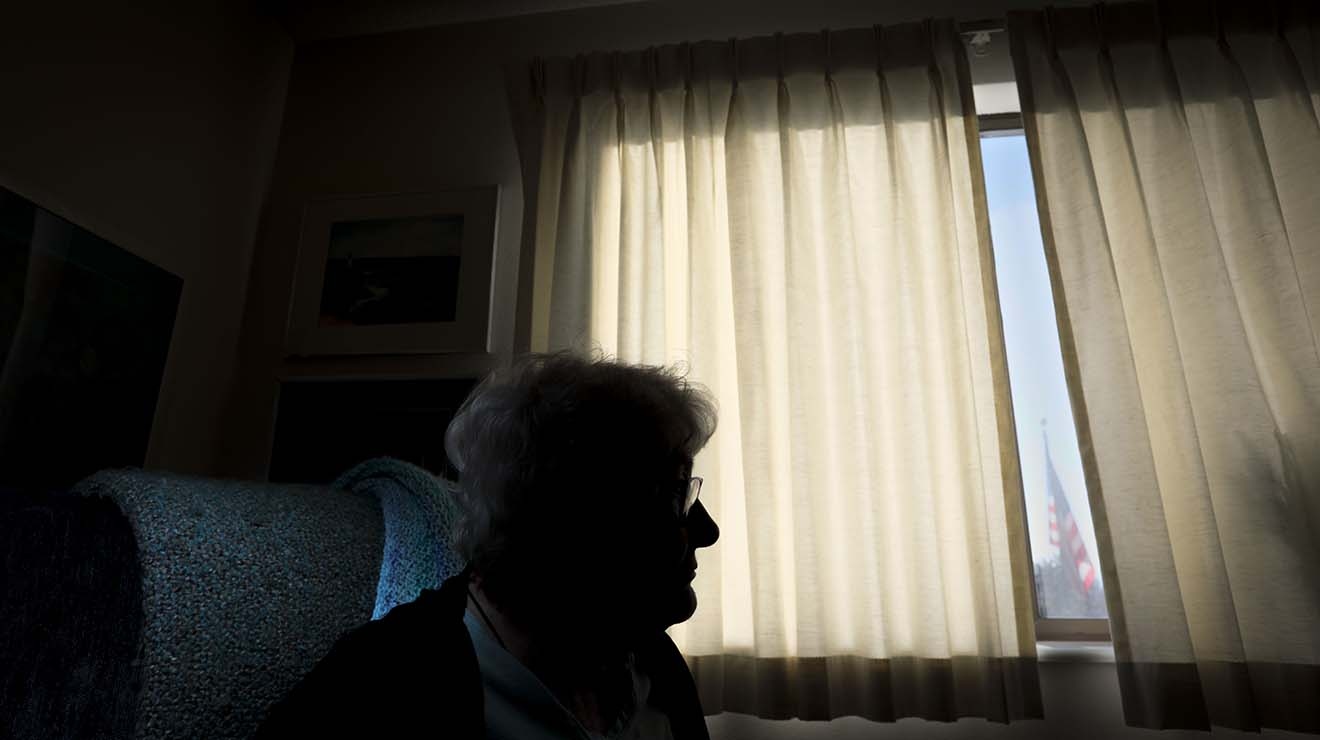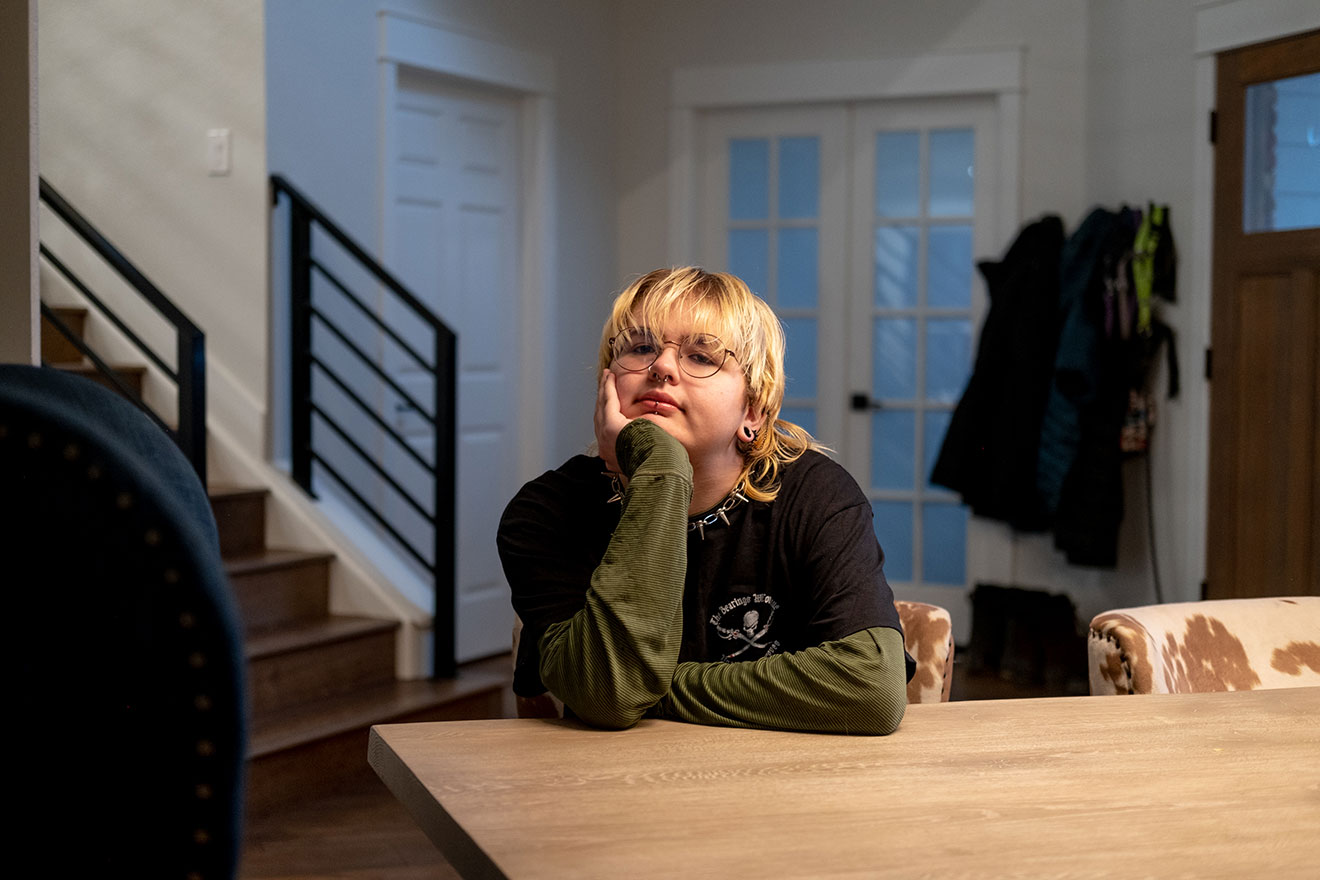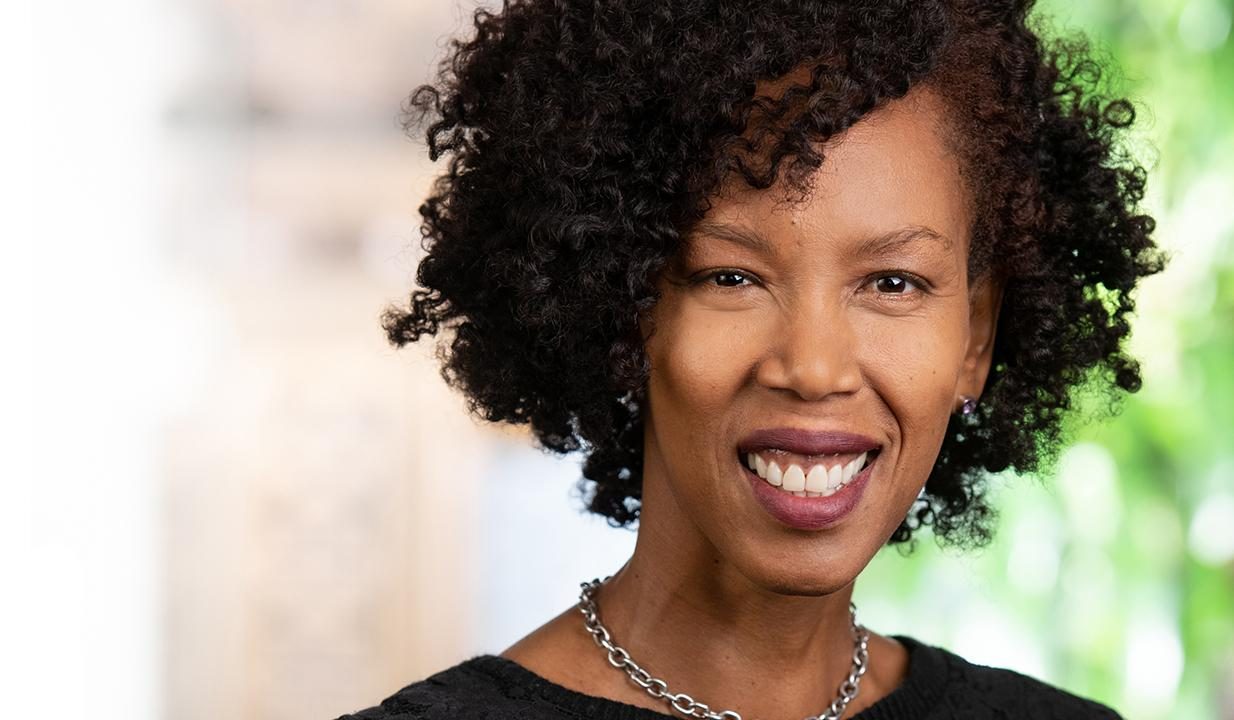After living in the closet for more than 40 years, Cynthia Johnson left her marriage with her high school sweetheart and embarked on a new life. She started dating women, continued to pursue a career in ministry and learned to be on her own for the first time.
Now, she’s 86 and largely back in the closet, “because I don’t trust how people are going to respond,” she said, “and they don’t need to know.” (Because of these concerns, “Cynthia Johnson” is a pseudonym.)
Johnson moved into Porter Place, a senior living community owned and operated by faith-based Centura Health, a little over 2 years ago after she fell while living on her own. Overall, she likes Porter Place. Her apartment feels homey, with furniture from her last place and photographs of family. Yet she’s been careful to avoid telling most residents and staff about her sexuality.
It’s not just that Porter Place doesn’t have anything online or in the windows of the facility that indicate it might be a place that’s welcoming of LGBTQIA+ people. It’s also that Johnson feels she did the work in her younger years to be openly lesbian and explain it to others. In her 86th year, she’s not going to be the one to help Centura Health change.
In a written statement, Centura Health said it does not discriminate against LGBTQIA+ residents or staff—”our faith calls upon us to cherish every life equitably,” the statement read in part—but declined to provide additional information about its policies or practices concerning LGBTQIA+ residents and staff.
Johnson has experienced a lifetime of living in a culture where discrimination against LGBTQIA+ people was normalized and used against her. She says she spent half her life with straight privilege, and she noticed the difference immediately when she came out.
For example, after leaving her marriage, Johnson started to address other issues in her life, including alcoholism. She went to a treatment facility in Montana where she intended to address her alcohol usage, as well as her comfort with being openly lesbian.
“There was one person, one woman, who was in treatment when I was, and she knew I was gay,” Johnson said. “She would lock herself in the bathroom, block everybody out of the bathroom, because she was terrified I’d come accost her in the bathroom.”
Johnson’s experiences have taught her that silence is often the safest option. When it comes to describing her relationship history to others, she keeps it simple: she is divorced.
“I was very much on guard for quite a while,” she said. “Because when I came out in the late ‘70s, early ‘80s, it was starting to be talked about and there was a lot of reactionary negativity.”
Johnson’s experiences are not unique. Carey Candrian, PhD, a researcher and associate professor of internal medicine at the University of Colorado School of Medicine, calls this phenomenon a “habit of silence.” Candrian’s work focuses on how communication can impact health care outcomes, especially for older LGBTQIA+ adults and their caregivers.
“If you grew up in this culture—where you were really trained to stay silent about who you were—of course over the years, if you continue to have these experiences you’re going to continue to stay silent,” Candrian said.
“They have literally developed this habit of silence to protect themselves. But in doing so, it has caused tremendous harm to both their physical and their mental health.”
Candrian points to findings from Harvard Medicine that LGBTQIA+ people can lose up to 12 years of their lifespans due to the stress of living in an environment marked by stigma and structural discrimination. (Editor’s note: while this story uses the LGBTQIA+ acronym throughout, the content of the studies and research referenced may use different variations of this acronym.)
Nationally, there are estimated to be about 3 million adults over the age of 50 who identify as lesbian, gay or bisexual, according to SAGE, an advocacy and services organization for LGBTQIA+ elders. By 2030, the number is projected to more than double as the population of people over 50 continues to grow.
In 2018, 60% of LGBTQIA+ older adults reported being concerned about how they will be treated in long-term care settings, according to a national survey of LGBTQIA+ older adults by AARP. Additionally, 20% of LGBTQIA+ older adults are people of color who as a group face increased health disparities, higher levels of stigma and have experienced more LGBTQIA+-related discrimination than their white counterparts, according to SAGE.
LGBTQIA+ older adults fear they might be refused care or risk neglect and abuse in assisted living or other elder care facilities. They also fear verbal or physical harassment from staff or other residents and their families. That fear, in combination with such facilities often lacking the resources to offer appropriate and inclusive care, forces many people back into the closet or keeps them there longer.
They have reason to be afraid—not only have they heard of discrimination from friends or family, they have experienced it in assisted living or elder care facilities themselves. In a survey from 2010, 43% of LGBTQIA+ respondents reported experiencing mistreatment in long-term care communities.
In turn, service providers often don’t realize they’re serving LGBTQIA+ individuals, so they don’t necessarily take measures to make their facilities more inclusive, and the cycle perpetuates itself. In the AARP survey, more than 82% of respondents said they would be more comfortable if long-term care facilities actively and intentionally affirmed LGBTQIA+ older adults. That includes changing policies, putting up rainbow flags and asking more inclusive demographic questions on intake paperwork.
Right before the COVID-19 pandemic, SAGE and the Human Rights Campaign Foundation, the educational arm of the nation’s largest civil rights organization, joined forces to further address issues in elder care and launched the Long-Term Care Equality Index.
The LEI, as it’s known, is the first national benchmarking tool designed to both assess a senior-housing community’s current services and assist them in adopting policies and procedures that promote LGBTQIA+-competent care. The LEI has free resources, technical assistance and a biennial survey to help long-term care communities revamp their inclusion efforts. SAGE already offered LGBTQIA+ competency training for facilities, area agencies on aging and other elder services organizations, but then introduced the LEI as a next step for long-term care communities.
In Colorado, four elder care organizations—Seasons Hospice & Palliative Care (now known as AccentCare) in Denver, the Colorado Chapter of the Alzheimer’s Association, Life Changes Care in Fort Collins and Project Visibility at the Boulder Area Agency on Aging—have received SAGECare credentials since 2016. Others have embarked on LGBTQIA+ inclusion and equity practices on their own, but without expansion of the LEI or some other ranking or review process, potential residents can’t compare facilities without doing the legwork themselves.
Sherrill Wayland, director of special initiatives with SAGE, said one of the most important things a facility can do to be more inclusive of LGBTQIA+ older adults is to update and publicize its nondiscrimination policies.
“If they don’t have an inclusive nondiscrimination policy, then that may be a signal to me that this isn’t a place that recognizes me for who I am,” Wayland said.
The next piece is how those organizations promote that information.
“Is it outward facing when people look at your website?” Wayland asked. “Are they seeing the nondiscrimination policy on brochures, or is it hidden in a policy manual that nobody knows about?”
Continued Wayland: “I think another key part is recognition around visitation and rooming policies—that LGBTQIA+ folks have the right to designate who their visitors are, and they have a right to live with their partner or a significant other and to be supported as a family in places that we call home when we age.”
Tamara Wright and Kim Harrell worry about rooming and the care they’ll receive if and when they enter an assisted living community.
They’ve been together for 32 years, but have not gotten married. Wright, 59, was diagnosed with multiple sclerosis 28 years ago and Harrell, 60, has epilepsy as a result of traumatic brain injuries when she was in her 20s and 30s. Their disabilities mean they need extra help around the house and with certain health needs, but because they are a gay couple they’re not always sure how caretakers will respond to them.
Once, a home care aide walked out on them. “When she realized where she was, she got up and she turned, she walked right out the door. We laughed, we howled,” Harrell said.
They brushed it off—they’ve experienced plenty of subtle and overt discrimination in their lives—but they wondered how that might have been different if they really needed help that day, or if they were in a facility where they couldn’t just ask for a different employee to assist them.
Harrell and Wright also worry that being unmarried, despite being partners for so many years, may impact their rooming choices or their ability to make decisions for one another’s health. Long ago, they gave each other power of attorney so that when Harrell had a seizure, Wright could make decisions about Harrell’s health and not be questioned by medical staff. But as they get older and their disabilities continue to progress, they worry that becoming more medically vulnerable may open them up to discrimination.
“If we’re not strong and we can’t stand up, that’s what frightens us,” Wright said. “We want to be able to be respected even if we can’t hold our bladders or whatever the case may be. We don’t want to be left behind because, you know, the staff is afraid of us or, you know, are disgusted by us.”
Across town at Dayspring Villa in Denver, a group of LGBTQIA+ residents and those identifying as allies gather every month to build community, discuss politics and, as one resident put it, “just be around other gays.”
The group started in December 2017 after Stormie Foust Maley, then an administrative coordinator for Dayspring Villa, went to a conference and listened to a panel discussion about marketing to LGBTQIA+ potential residents. She got the idea to start a gay-straight alliance and knew of one openly gay man in the community. Together, they started the group.

A rainbow-colored face mask hangs from a wheeled walker as LGBTQIA+ seniors and staff hold one of their recurring affinity group meetings at Dayspring Villa in Denver in October 2022.
“We had several people who showed up that I didn’t expect to be there,” Foust Maley recalled. “Some folks who were LGBT had never felt comfortable talking about that in our community, even though they had lived here for years. … I thought it was going to be kind of a small group, and it turns out we actually have a much bigger need than I had realized in our community for this.”
It was a humbling realization. Foust Maley and Christian Living Communities, the Lakewood-based organization that runs Dayspring Villa and other elder care facilities, pride themselves on building relationships with residents and forming close connections with them.
“It was difficult for me to realize that we had residents here who had a pretty important part of their identity that they didn’t feel safe to be open about, that they didn’t know they would be accepted, that they didn’t know if staff would treat them well, or if they would be welcome in our community,” Foust Maley said.
Christian Living Communities is actively working to ensure its facilities are LGBTQIA+ inclusive and welcoming. One way is through its “We Belong” initiative. The organization recently produced a video as part of this effort, and is working with Candrian to develop inclusive and equity-focused curricula and materials for both staff and residents.
“We know that when people really belong somewhere, their health outcomes are better and their well-being is so much improved. Just because somebody moves into a community doesn’t mean they feel like they belong,” said Jill Vitale-Aussem, president and CEO of Christian Living Communities. “It’s really, really important to us that everybody—the people that work here, that live in our communities—truly can experience belonging.” She pointed to the work Foust Maley has done at Dayspring Villa as an important part of the organization’s overall effort.
During the meeting at Dayspring Villa, some residents brought up how the “Christian” in the organization’s name might be off-putting at first and could imply the organization might reject LGBTQIA+ identities—but Vitale-Aussem said it’s the exact opposite.
“When we really look at what the ‘Christian’ means in our name, it’s a place that is loving and welcoming for everyone,” she said. “I know there’s a lot of different definitions of what ‘Christian’ means right now, but that’s what it means to us. And our mission statement has always, always, always called us to honor, include, love and accept everyone.”
Foust Maley was determined to push for more change at Dayspring Villa and share her insights with other elder care communities. She would hear from other facilities that there weren’t any LGBTQIA+ residents, but she could share from personal experience that there almost definitely were.
“I didn’t know how big the need was because the stakes are too high for residents sometimes to share this really important part of who they are,” Foust Maley said. “If they think that they won’t receive equitable care, if they think that they won’t be welcome in the communities where it’s hard to give up some of our independence—it’s hard to need care. You’re in a vulnerable position.”
For Johnson, who went back into the closet at her assisted living facility, one couple who she’s befriended has made a big difference.
The wife’s brother is gay and the couple told Johnson about him, and made it clear that they would accept her as she is. She’s out to them and a few select friends in the community, but, that’s it.
“It was a relief,” Johnson said.
This article was written with the support of a journalism fellowship from The Gerontological Society of America, The Journalists Network on Generations and The Commonwealth Fund.





